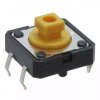I have a circuit board with 12mm tactile switches and caps that extend through a 3mm acrylic panel. I want to add a piezo beeper that will be flush against the back of the panel, but the beepers are slightly too thick to match the switch height. If I make a sub-board to mount the beepers through a hole in the main board, the elevation is almost perfect, and I can mount the beeper just a bit off the sub board to fit exactly right.
I'm trying to figure out the best way to solder the sub board to the back of the main board. I want minimal thickness between the 2 boards. I guess castellated holes would be the usual approach, but this increases board costs significantly. The main board is mostly surface mount, so one way to do it would be some matching pads on the two boards with solderpaste. Or maybe some large-ish plated through holes soldered with paste or by hand. I could also just insert a screw through each hole and depend on the annular rings making good-enough contact.
Anybody done anything like this? Suggestions?
I'm trying to figure out the best way to solder the sub board to the back of the main board. I want minimal thickness between the 2 boards. I guess castellated holes would be the usual approach, but this increases board costs significantly. The main board is mostly surface mount, so one way to do it would be some matching pads on the two boards with solderpaste. Or maybe some large-ish plated through holes soldered with paste or by hand. I could also just insert a screw through each hole and depend on the annular rings making good-enough contact.
Anybody done anything like this? Suggestions?





